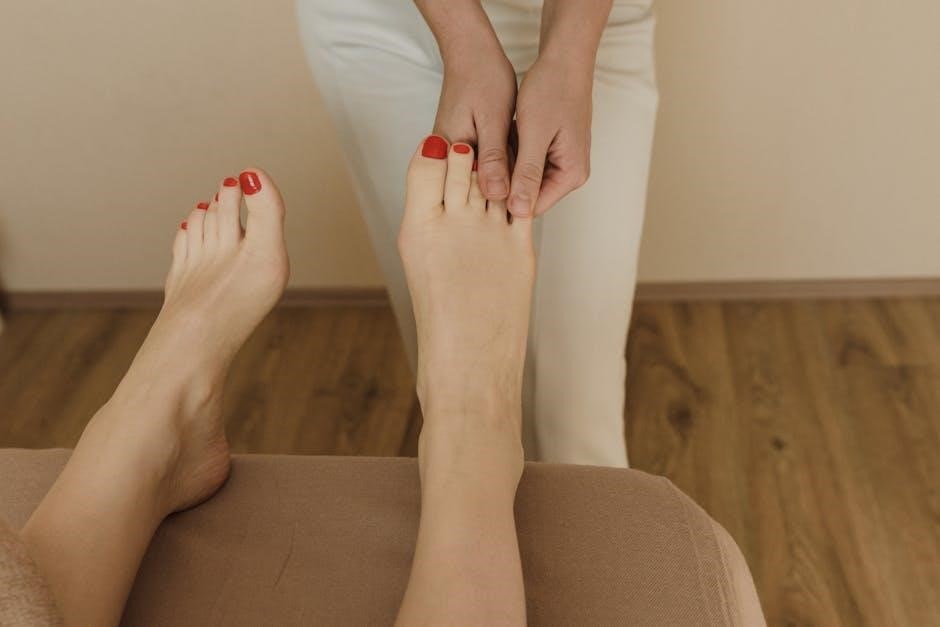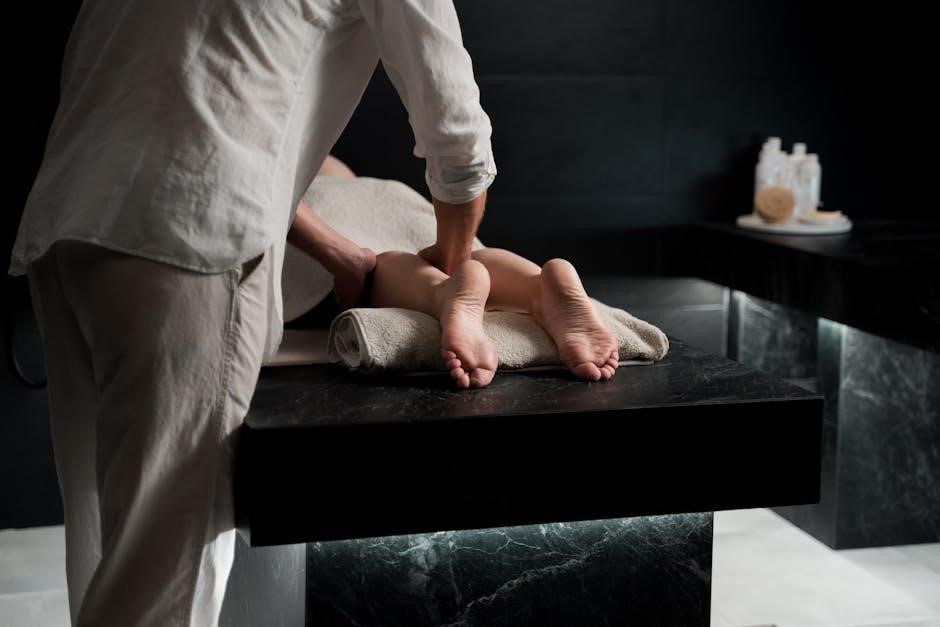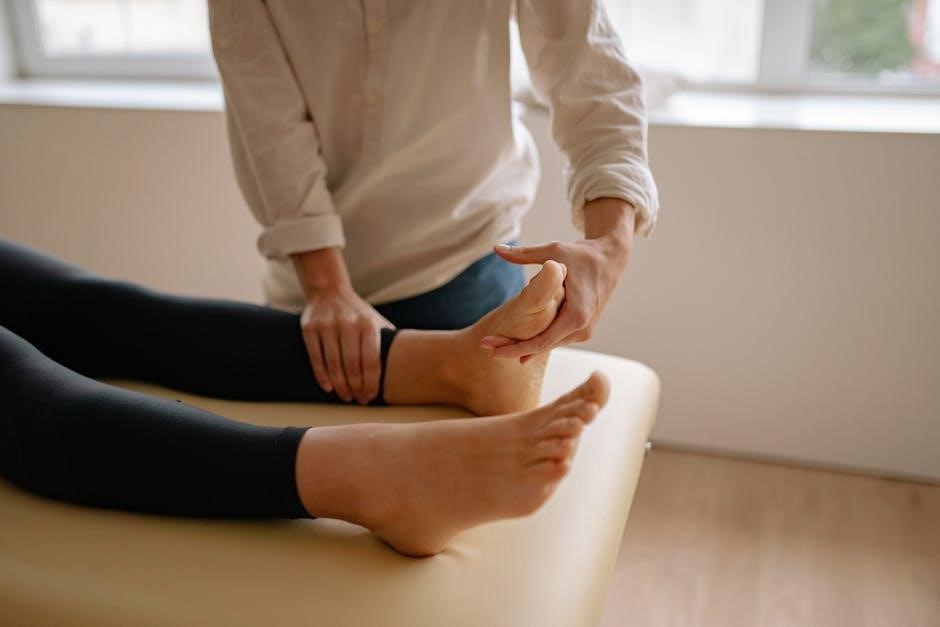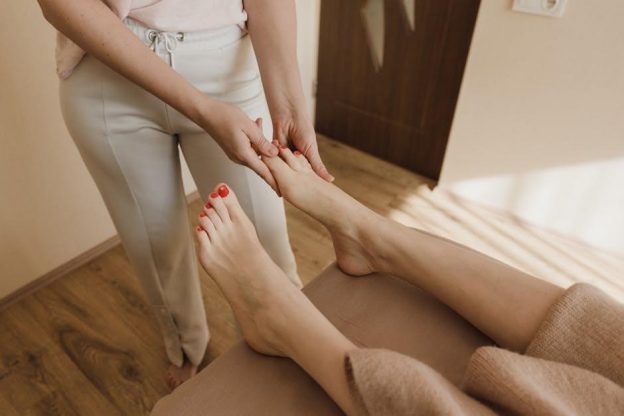Foot massage has been used for centuries, offering a holistic approach to wellness by combining manual techniques with reflexology points to promote relaxation and overall health benefits.
1.1 What is Foot Massage?
Foot massage is a therapeutic practice that involves manual techniques applied to the feet to promote relaxation, relieve pain, and improve overall well-being. It combines gentle rubbing, kneading, and tapping methods, often with the use of oils or lotions, to stimulate blood flow and ease muscle tension. This practice can also incorporate reflexology, focusing on specific pressure points believed to connect to various organs and systems in the body. Whether performed professionally or at home, foot massage is a simple yet effective way to unwind and enhance physical and mental health.
1.2 Importance of Foot Massage for Overall Health
Foot massage is essential for overall health, offering a holistic approach to wellness by addressing both physical and mental well-being. It enhances blood circulation, which is vital for delivering oxygen and nutrients to cells, while also aiding in the removal of toxins. By targeting nerve endings and reflexology points, foot massage can alleviate stress, reduce muscle tension, and promote relaxation. Regular practice supports mental health by lowering stress levels and improving mood. Additionally, it strengthens immune function and boosts energy, making it a natural therapeutic tool for maintaining a healthy and balanced lifestyle.

Benefits of Foot Massage
Foot massage improves circulation, relieves stress, and promotes relaxation. It alleviates pain, enhances sleep quality, and supports digestion, offering holistic benefits for both body and mind.
2.1 Physical Benefits: Improved Circulation and Pain Relief
Foot massage enhances blood flow, warming the muscles and improving circulation. This helps reduce swelling and promotes healing. Gentle techniques like kneading and pressing relieve muscle tension, while targeted pressure on reflexology points alleviates pain. Improved circulation strengthens the immune system and supports overall physical well-being. Regular foot massages can also reduce inflammation and stiffness, offering relief for conditions like arthritis. By addressing physical discomfort, foot massage contributes to a healthier, more active lifestyle, enhancing quality of life and ensuring optimal bodily function.
2.2 Mental and Emotional Benefits: Stress Relief and Relaxation
Foot massage offers profound mental and emotional benefits by alleviating stress and promoting deep relaxation. The gentle pressure on nerve endings in the feet triggers a calming response, reducing anxiety and tension. Regular massages can enhance feelings of well-being, fostering a sense of calm and emotional balance. This therapy also helps reduce symptoms of depression and fatigue, promoting mental clarity and resilience. By creating a soothing experience, foot massage supports overall mental health, enabling individuals to cope better with daily pressures and maintain a positive outlook on life.
2.3 Additional Benefits: Improved Sleep and Digestion
Foot massage extends its benefits to enhancing sleep quality by promoting relaxation and reducing stress. The calming effects of the massage help individuals unwind, making it easier to fall asleep and stay asleep. Additionally, stimulating specific reflexology points on the feet can improve digestion by enhancing gut function and reducing symptoms of bloating and indigestion. Regular foot massages can also alleviate digestive discomfort, supporting a healthier digestive system. These benefits collectively contribute to a better overall quality of life, making foot massage a versatile and holistic wellness practice.

Foot Massage Techniques
Foot massage techniques range from basic methods like rubbing and kneading to advanced practices such as reflexology and deep tissue massage, promoting relaxation and circulation.
3.1 Basic Techniques: Rubbing, Kneading, and Tapping
Basic foot massage techniques include rubbing, kneading, and tapping, which are simple yet effective for promoting circulation and relaxation. Rubbing involves gentle, gliding strokes over the skin, often used to warm up the feet. Kneading targets muscles and tissues, helping to relieve tension and stiffness. Tapping, or percussion, stimulates nerve endings and can energize the body. These methods can be performed with or without massage oils or lotions, making them accessible for home use. Regular practice of these techniques enhances flexibility, reduces muscle soreness, and prepares the feet for more advanced massage practices.
3.2 Advanced Techniques: Reflexology and Deep Tissue Massage
Advanced foot massage techniques include reflexology and deep tissue massage, which target specific areas for enhanced therapeutic benefits. Reflexology focuses on pressure points linked to organs and systems, promoting holistic wellness. Deep tissue massage targets connective tissue and fascia, relieving chronic pain and inflammation. These methods require precision and pressure, often incorporating tools or specialized oils. When performed correctly, they can address long-standing issues like plantar fasciitis or sciatica. Mastery of these techniques enhances the effectiveness of foot massages, offering profound relaxation and physical relief for those seeking deeper therapeutic outcomes.

How to Perform a Foot Massage Routine
Begin with a warm-up, using gentle circular motions and massage oil to prepare the feet. Focus on applying pressure and soothing strokes to enhance relaxation and circulation.
4.1 Preparing for the Massage: Warm-Up and Tools
Begin by warming up the feet to enhance circulation and relaxation. Soak the feet in warm water or use a gentle foot roller to prepare the muscles. Use a massage oil or lotion to reduce friction and allow smooth strokes. Essential tools include a massage roller, cream, or even your hands. A warm-up ensures the feet are ready for deeper pressure, making the massage more effective and comfortable. This preparation step sets the foundation for a therapeutic and enjoyable foot massage experience.
4.2 Step-by-Step Massage Process: From Heels to Toes
Start by gently massaging the heels with circular motions using your thumbs. Gradually move to the arch, applying steady pressure to relieve tension. Use long strokes to knead the ball of the foot, then focus on each toe, massaging from base to tip. Rotate each toe gently to release stiffness. End with light, soothing strokes along the sole to promote relaxation. This systematic approach ensures all areas of the foot are attended to, providing both comfort and therapeutic benefits. Regular practice enhances the effectiveness of the massage routine.

Foot Reflexology and Its Role in Wellness
Foot reflexology targets specific pressure points to support overall health, reducing stress, alleviating pain, and improving circulation, while promoting emotional and physical well-being naturally.
5.1 Understanding Reflexology Points on the Feet
Reflexology points on the feet correspond to specific organs and systems in the body. The soles contain zones linked to the solar plexus, liver, and heart, while the toes connect to the head, neck, and spine. By applying pressure to these points, individuals can stimulate energy flow and balance. Techniques like circular motions or deep presses can target areas to relieve tension and improve circulation. Regular massage of these points may enhance overall well-being, reduce stress, and promote relaxation. Understanding these points allows for a focused approach to addressing specific health concerns and maintaining holistic wellness.
5.2 How Reflexology Supports Overall Health
Reflexology supports overall health by enhancing circulation, reducing pain, and promoting relaxation. It targets specific reflex points linked to organs, improving their function. Regular sessions can lower stress, boost mood, and aid digestion. Reflexology also helps manage symptoms of anxiety and fatigue, offering a natural way to restore balance. By stimulating these points, it strengthens the immune system and supports mental clarity. This holistic practice complements traditional therapies, providing a comprehensive approach to wellness and improving quality of life for individuals seeking natural health solutions.
Foot massage is a simple yet powerful practice offering holistic benefits for mind, body, and spirit. Regular sessions can enhance overall well-being and foster relaxation.
6.1 Final Thoughts on the Value of Foot Massage
Foot massage is a timeless practice offering profound holistic benefits. It enhances circulation, alleviates pain, and promotes mental relaxation. Regular sessions can improve sleep quality, boost energy, and support overall well-being. By incorporating foot massage into your routine, you can address physical discomfort and emotional stress while fostering a deeper connection to your body. Its accessibility and effectiveness make it a valuable tool for maintaining health and wellness in a busy world. Embrace this simple yet powerful practice to rejuvenate your mind, body, and spirit.
